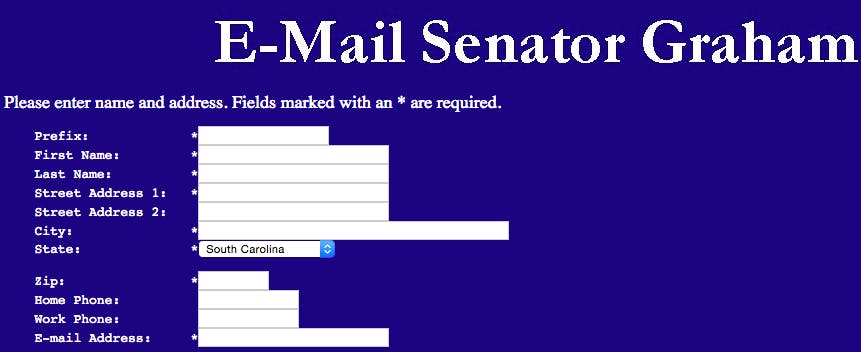By claiming he’d never sent an email, Sen. Lindsey Graham (R-S.C.) this week sent shockwaves through all but the most hardened cynics in American politics.
“I don’t email,” he told Meet the Press’s Chuck Todd on Sunday. There was little question of what he meant. “I’ve never sent one,” he added. He has since reiterated that stance, though he says he texts, and “I’ve got iPads.”
The 59-year-old Graham, who’s been in Congress since 1995, is definitely in the minority. A 2011 Pew study found that 92 percent of American adults use email. But that percentage, which surely has increased in the past four years, gets even higher as you hone in on Graham’s demographic. Ninety-three percent of whites—Graham is white—used it, the study found, as did 96 percent of college graduates and 98 percent of those who make at least $75,000 a year. Graham’s estimated net worth in 2009 was $834,812; other sources have since put that estimate at nearly twice that.
So if this likely presidential candidate has never used email, it’s worth looking at choices he’s made as a legislator, knowing now that he hasn’t—or at least he claims he hasn’t—ever sent the most basic and widespread form of online communication.
- 2003: As seen in a cached version of Graham’s website, captured by the Internet Archive, the earliest versions of his site—“best viewed with Internet Explorer”—invited you to email him.
- 2004: Sometime between March 13 and 20, Graham’s site gets an upgrade. Among the changes? It no longer offers the chance to “E-Mail Senator Graham,” but instead to “contact us.”
- May 2008: Graham’s team creates his first official Twitter account, @grahamblog. Three and a half years later, he creates a second one, @lindseygrahamsc. Both accounts sometimes tweet from the first person:
.@ChuckGrassley you recognize this guy? I ran into him at the Iowa State Capitol yesterday. @PatGrassley pic.twitter.com/TVoIsyhmNl
— Lindsey Graham (@LindseyGrahamSC) February 20, 2015
.@SenatorTimScott and I great time meeting with South Carolinians in DC today for the #MarchforLife2015. pic.twitter.com/camBCalC1R
— Lindsey Graham (@GrahamBlog) January 22, 2015
Graham’s office didn’t respond to the Daily Dot’s query of whether he’s actually ever personally tweeted from those accounts.
- June 2008: Graham votes for the Foreign Intelligence Surveillance Amendments (FISA) Act, which authorizes, among a host of other things, the National Security Agency’s PRISM program to tap American tech companies’ servers for stored user communications. Graham voted for the bill in 2008 and for its reauthorization in 2012.
- 2010: In a Washington Post op-ed jointly written with Sen. Chuck Schumer (D-N.Y.), Graham proposes a solution to immigration: “We would require all U.S. citizens and legal immigrants who want jobs to obtain a high-tech, fraud-proof Social Security card.” Marc Rotenberg, president of the Electronic Privacy Information Center, had previously testified before Congress that such a concept—one somehow completely immune to fraud, at least—isn’t just against most notions of modern privacy; it’s technologically infeasible.
- 2011: Graham is one of 41 senators to cosponsor the notorious Protect IP Act (PIPA), the Senate counterpart to the Stop Online Piracy Act (SOPA), which would have made it far easier to censor websites accused of copyright infringement. (Both bills were shelved after an unprecedented campaign against them.) Graham is not among the 10 senators who then withdrew their support, though the bill never went before a vote.
- 2013: In an interview, Graham addresses an invisible Edward Snowden, who has leaked information about PRISM and the NSA’s program to track American phone records—a program Graham wholeheartedly supports. Despite his unfamiliarity with the services PRISM affects, he tells Snowden that his leaks likely had fatal consequences. “You’ve gotten some people killed, probably,” he says.
Graham currently sits on the Senate Subcommittee on Privacy, Technology and the Law.
Photo via Chairman of the Joint Chiefs of Staff/Flickr (CC BY 2.0)



